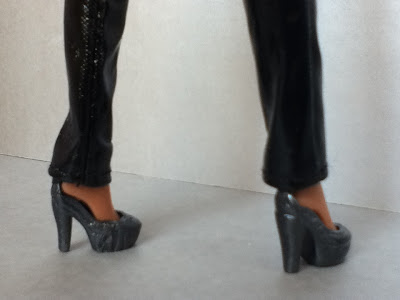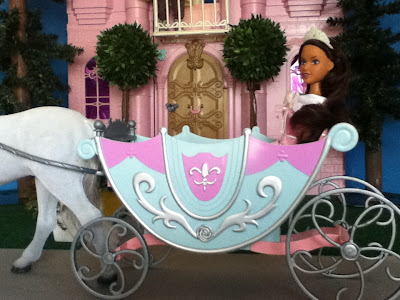Thus, I was eagerly awaiting the release of the Prettie Girls designed by Stacey McBride Irby who created the So In Style line. One World Dolls is a black-owned company that I would have liked to support, but in over a year they haven't delivered any Prettie Girls to market. Kenya's World, LLC is not a black owned company, but this Christmas season they have created a product line and devised a marketing campaign that meets African American consumers' demand for dolls that reflect the full spectrum of our beauty right in our own neighborhoods at local Family Dollar stores.
So how do the Kenya Fashion Madness dolls stack up compared to Mattel's So In Style line? This week I de-boxed the Beverly Hills, Moving On, and Vegas models to find out. Doll nudity to follow.
***
Fashion Madness Kenya dolls have oversized heads like Mattel's My Scene girls or Disney's Princess Tiana. They also have tons of hair but shoulder to shoulder with So In Style dolls, they are about the same height up to the neck. Here Kenya is on the left, and So In Style Grace is on the right.
Compared to the Barbie "belly button" body, however, Kenya is built for comfort rather than speed. Her bosom is more voluptuous,
Although some early So In Style dolls had articulated wrists and elbows, another one of my frustrations with Mattel is that they have only offered us one darker complexion in the fully articulated Fashionista line. Kenya comes in three luscious flavors:
Granted the bodies do not feel as sturdy as Barbie Fashionistas and the range of motion in the knee joints is not as great. The Artsy Fashionista body can pose with the knees turned gracefully to the side:
Although Kenya's legs don't gape open like Disney's articulated Princess Tiana dolls when she is seated, she is not as demure as Artsy:
Nevertheless, Kenya dolls offer a wider variety of body upgrade options for our dolls with darker complexions. Just be sure to slice the head off with an Xacto knife. The neck prong is wicked and subject to break:
Yet, for $20 you can often get a So In Style doll with a cute little sister and both will be dressed in the well-made clothes that have made the Barbie brand synonymous with quality. The Kenya Fashion Madness dolls are currently priced at $5 more than a standard Barbie Fashionista. Are the clothes worth that extra premium or are we paying a "black tax" for articulated dolls with deeper complexions?
Beverly Hills Kenya sports a workable suit which is not common in the current wave of girly pink Barbie fashions. The jacket and skirt are made of lightweight cotton in an interesting polka dot print.
While ice blue was an intriguing color to pair with the black and white suit, in my opinion the terry cloth fabric is a less successful design choice. The line of this sleeveless tunic also does not flatter Kenya's thicker figure.
Meanwhile the belt is a cheap strand of beads that will most likely pop in the process of dressing and undressing the doll.
The jewelry, however, is a nice change from the molded plastic accessories that usually come with play line dolls. The necklace is a chain of metal beads and the earrings are metal disks securely attached to strong wires. The shoes are very stylish and dainty.
Meanwhile I found that Kenya can wear Kari Michelle tops (but not bottoms) and swapped out the terry cloth sack.
All in all, this suit has infinite possibilities.
Next I deboxed Movin' On Kenya.
The leopard print coat and matching bag are very chic even though the bag is stitched shut.
Instead of bunching and adding thickness at the waist like the terry cloth sack, this red knit tunic hugs Kenya's curves.
Kenya can stand unaided in these boots and they are slit up the back for easy removal.
The velour leggings are not made of top quality fabric and it would probably be a struggle to put them on a doll with soft vinyl legs. Still, the Movin' On ensemble is my favorite Kenya fashion.
Indeed, many of my other ladies would like to throw Kenya down for her furs and jewels so she generously allowed SIS Grace to model the Vegas ensemble.
This white fur coat sheds a lot but it looks sharp and the purse is a megawatt marvel.
The faux leather pants are a little roomy in the seat but the shoes are a perfect fit so unlike Liv dolls, Kenya dolls can share all their shoes with Barbie and her friends.
With glittering gold beads stitched to a shimmery top, this ensemble packs plenty of glitz and glam but mercifully none of it is pink!
***
In summation, Kenya has a pretty face if you don't mind oversized heads.
I used all three of my Kenyas as body donors, however.
The final verdict? Although the Kenya Fashion Madness line targets a specific market niche, with $5 worth of fresh ideas in each of the Fashion Madness designs, these play line dolls bring some much needed diversity to the market.
À Bientôt

































































